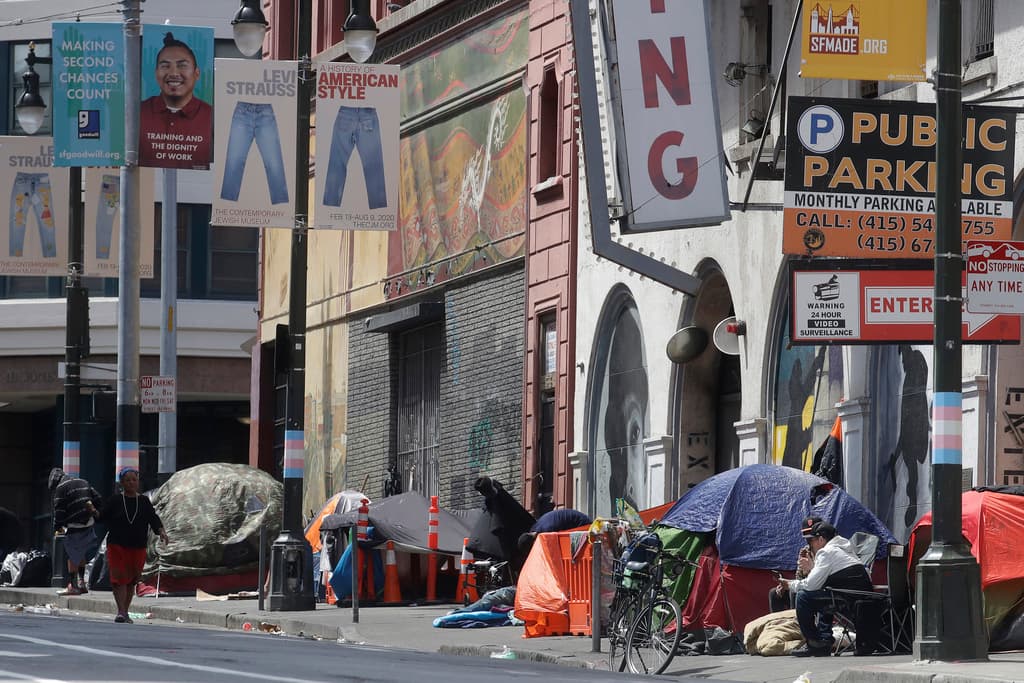Williams-Sonoma To Close at San Francisco, as Residents Debate Whether the City Is in a ‘Doom Loop’
‘Our cops aren’t getting out of their cars, the governor has called in the National Guard, graffiti is everywhere.’

News that Williams-Sonoma is the latest San Francisco business to announce it will be shuttering its downtown flagship store is prompting a debate over whether the city is in a “doom loop.”
The upscale home goods store joins a growing list of luxury and mid-tier retail businesses around Union Square, the heart of downtown, to announce their closures. Among these are Nordstrom, Saks Off 5th, Christian Louboutin, Ray-Ban, Lululemon, the Gap, and Anthropologie.
Of the 203 retail businesses open in 2019 at the Union Square area, only 107 remain, according to the San Francisco Standard. That’s a 47 percent closure rate since the start of the pandemic. A total of 12 new businesses have opened since then, though two have already announced closures. The figures also don’t include the nearly 100 stores inside the downtown Westfield mall, in which Nordstrom is an anchor tenant.
“Our city is in this downward spiral we call a doom loop,” a civil rights attorney, Joe Veronese, who ran an unsuccessful campaign for San Francisco district attorney in 2022, tells the Sun.
In early May, Nordstrom announced it will be shuttering both its downtown locations, telling employees in an email that, “the dynamics of the downtown San Francisco market have changed dramatically over the past several years, impacting customer foot traffic to our stores and our ability to operate successfully.”
A city reliant on its tech workers to come to offices downtown and spend money at its stores and restaurants, San Francisco took a major hit when these companies ordered their employees to work from home during the pandemic. Much of this workforce has still not returned in person.
Out of 62 North American cities, San Francisco is the slowest to recover from the hollowing out of its downtown, according to a November 2022 study of mobile phone data in downtown areas.
Strict pandemic restrictions further hurt businesses, and looting after the George Floyd protests scared off many customers who saw boarded up stores and viral videos of the melee. On top of that, the crises of homelessness and drugs are scaring tourists and shoppers from visiting downtown.
Tents line sidewalks in the Tenderloin neighborhood, adjacent to Union Square. Open-air drug use is rarely policed. Scraps of aluminum foil used to smoke fentanyl litter the streets. Car break-ins and retail theft remain persistent problems, particularly since theft under $950 is a misdemeanor and, in many stores, simply tolerated since offenders will anyway get only a slap on the wrist.
“Our cops aren’t getting out of their cars, the governor has called in the National Guard, graffiti is everywhere,” Mr. Veronese says. “Now, people just go and break windows like there’s no consequence because there is no consequence. You could go into Walgreens and steal as much stuff as you want and walk out and not be charged. It happens daily.”
Nordstrom did not mention retail theft or the drug-fueled homelessness crisis as reasons for its planned closures, but the owner of the Westfield mall did, saying it “underscores the deteriorating situation in Downtown San Francisco.”
“A growing number of retailers and businesses are leaving the area due to the unsafe conditions for customers, retailers, and employees, coupled with the fact that these significant issues are preventing an economic recovery of the area,” a statement from the Westfield mall owner says.
In April, Whole Foods announced the closure of its flagship store near Civic Center, citing employee safety concerns. Situated near the heart of the city’s open drug scenes, the store and its employees had to contend with rampant shoplifting and persons in the throes of mental health crises and addiction. In September, a man overdosed and died in the grocery store’s bathroom.
A video taken inside a San Francisco Target store went viral last month because every item for sale was locked behind glass. A video of a man bicycling out of a Walgreens after stuffing a garbage bag full of goods went viral in 2021. Both illustrate the depth of the shoplifting problem. When I visited the city last year and went into a Walgreens, I too saw a person brazenly walk out with candy and a drink.
“You sit there and you think to yourself, why am I paying for all these goods?” Mr. Veronese says. “We’re sending the exact opposite message right now to criminals.”
Before the tech boom, liberal San Francisco was a hippie mecca, a center of the gay rights movement, and a countercultural hub accustomed to drug use — all still parts of its idiosyncratic social fabric. The city has also always had a large homeless population and is a place that tolerates a certain level of street dysfunction. The fentanyl crisis, though, is testing residents’ limits.
The homeless population has ballooned to nearly 8,000. Unlike New York City, which has a “right to shelter” law and can clear tent encampments, San Francisco (as well as other west coast cities) is hamstrung by a 9th Circuit ruling that they cannot clear tents without adequate available shelter beds. Instead of building more emergency shelter, the city is investing in a “housing first” model that is slow and costly to implement.
The city’s homelessness and supportive housing budget tops more than $600 million a year. Mayor Breed is also pushing a plan to spend an additional $600 million on housing to try to cut the unsheltered homeless population in half by 2028. Meanwhile, the City by the Bay is facing a $780 million two-year budget shortfall.
The governor has called in the California Highway Patrol and National Guard to help the city crack down on drug dealing and fentanyl trafficking. District attorney Brooke Jenkins is taking a more aggressive posture to prosecuting fentanyl dealers than her predecessor, Chesa Boudin, who was recalled nearly one year ago. Yet there seems to be little appetite for stopping the demand side of the drug market.
There is a prevailing sense that the progressive city government is failing its residents, with its focus solely on harm reduction and “housing first” and with no treatment or recovery component. Pushback is getting louder.
Yet other San Franciscans say the “doom loop” predictions are wrong, that San Francisco always bounces back, and that the obsessive media focus is “annoying.”
“I think it’s over-exaggerated,” commercial real estate brokerage Cushman & Wakefield’s vice chairman, Kazuko Morgan, tells the Sun. “We have challenges like every other major, big city.”
Ms. Morgan says Williams-Sonoma’s announced closure was expected. She says the company was looking for a buyer of its building prior to the pandemic, and that the fact Chanel purchased it for $63 million and is planning to open a store there speaks volumes. She says Nordstrom flagship was simply too big for the era of online retail. She also cites as proof the city’s retail sector isn’t dying plans by Ikea to open a large retail location near the recently closed Whole Foods.
It’s hard, though, to dispute the numbers. Retail and office space vacancies are at 30 percent. No matter the cause, stores are closing.
“The problem with Union Square is it butts up against the Tenderloin,” Ms. Morgan says. “If you had Skid Row a block away from Rodeo Drive you would have the same issue.”
Twitter’s chief executive, Elon Musk, is more critical. “You could literally film a Walking Dead episode unedited in downtown SF,” he tweeted. “This is where San Francisco politics leads and Twitter was exporting this self-destructive mind virus to the world.”
Another tech chief executive, Chris Larson, the founder of Ripple, is betting that San Francisco will bounce back. His company just signed a lease on 130,000 square feet of office space downtown.
“We’ve seen this many times before. San Francisco is a story of boom, bust, and kind of reinvention,” Mr. Larson says. “This is one of those transformations you haven’t seen in 50 plus years.”

